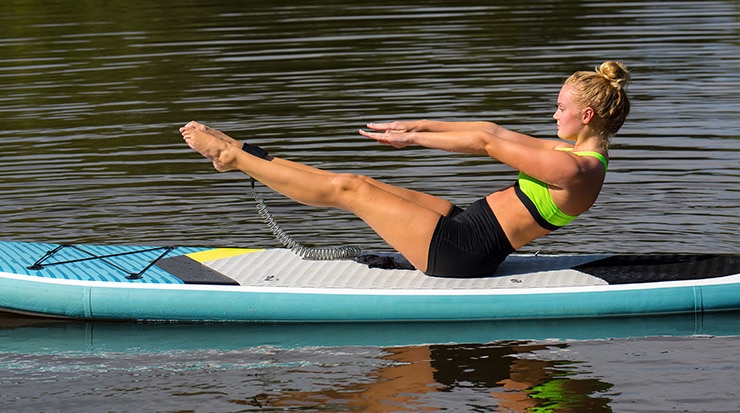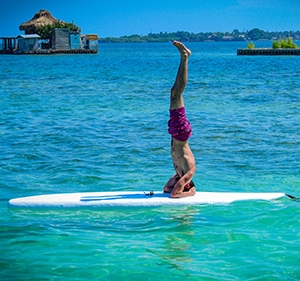When it comes to most things in life, you can’t take a one size fits all approach. Luckily, in the world of paddle board yoga, that’s not quite the case.
Ask any water yogi and they’ll tell you that the number one thing you need for practicing yoga on the water is a great yoga board.
With that being said, you’re probably wondering, what size paddle board should you get for yoga on the water? Well, today we’ll talk all about sizing, board features, and all the other good stuff you should consider if you want a great yoga board.
RELATED: What is the best SUP for yoga in 2024?
Choosing The Best Size Paddle Board for Yoga
Quality built paddle boards for yoga are definitely worth the investment for anyone wanting to get into SUP yoga. The size you get is largely determined by your own size, weight, and skill level. Opting for a wide inflatable SUP board with a displacement hull (rather than a displacement hull) is a good place to start.
Across the board (pun intended) the stability of your yoga board is a feature dictated by its width and the thickness of the board.
A good yoga board is one that is wide enough so that it offers a lot of surface area, making balancing easier. It’s also one that has an even thickness across the width. Most hardshell paddle boards that are designed for versatility and maneuverability taper off at the edges. This gives you the ability to be agile in the water and be in full control of your board’s performance.
A yoga paddleboard on the other hand shouldn’t have that tapered effect. You should have the same thickness across the board in order to maintain that surface area giving you the stability you need for balancing as you practice yoga.

Best Dimensions for a Sup Yoga Board
Let’s start with numbers. A good yoga SUP is one that is wide enough to give you the stability you need for balancing with tricky yoga poses. Typically, you’ll want to aim for a board that is 32 to 36 inches at its widest point. Anything 32 inches and smaller will be ticky for you to keep your balance as you go through your yoga routine.
The length of your yoga board is the next important factor to consider. You want a board that is long enough for you to stretch out on completely. When you’re doing a full body stretch, you don’t want your head or feet to be teetering too close to the board’s end.
The shape of the nose and tail of the board are also important to consider. Avoid a board that has too narrow of a nose as this will contribute to a less stable experience.
An ideal board for yoga will have ends that are wide and rounded. The tail end of the board should be particularly broader, much more so than the nose. Typically, the best yoga board will be one that is 10 to 11 feet long.
The next important factor to consider is board thickness.
As I mentioned, it’s important that the thickness stays consistent across the whole width of the board. Because of this, inflatable stand up paddle boards tend to be the best option to use during your SUP yoga session. Inflatable paddle boards also tend to be more comfortable as they have a cushioned deck to complement poses on your joints
Unlike hard-shelled boards that tend to taper off at the edges, a consistent thickness like that found on inflatable boards will give you really good stability. Look for an inflatable board that’s 4 to 5 inches thick.
ALSO READ: How hard is paddle board yoga for beginners?
Paddle Board Width Matters, But This Matters Too
As I’ve mentioned, your board’s width really is synonymous with the level of balance you’ll achieve. The width of an inflatable SUP board is not the only factor that contributes to the stability of experience, the thickness of the board will matter as well.
Take, for example, a yoga board that is 36 inches wide, 6 inches thick, but has tapered edges. This board will give you enough surface area, but you’ll find yourself wobbling through your yoga routine. On the other hand, a board that is 32 inches with a consistent thickness of five inches will offer less deck space but greater stability and much less wobble.
Though width matters a lot when you’re shopping for a yoga board, don’t just focus on this feature exclusively. Take into consideration that thickness and the length and how those will factor into your experience on the water.
What’s The Optimum Length for a Yoga SUP?
While length does not play as important a role as your board’s width does, it is still an important factor to consider. The length of a paddleboard will really come into play if you are planning to incorporate different full-body stretches. Stretches like star stretches, deep lunges, and splits will require ample board space for you to stretch out.
It can also be important to consider length if you’re bringing along additional accessories with you. If you have a longer board, you can use the front or back end as a storage area for any additional gear you might bring with you.
Fin Setup and Stability
Overall, the fin setup won’t play a whole lot into your overall SUP yoga experience. Plus, your board’s fins won’t really impact your overall stability.
Having a board with three fins can be tricky though. If you want to practice with your yoga SUP on land, the fins can get in the way of doing this – so having a board with a removable center fin is an idea. Dedicated yoga boards do tend to have removable fins to allow for different configurations.
Other Yoga SUP Features to Look Out For

When you’re shopping around for a yoga sup boards, it’s best to ignore the marketing hype. There are specialized boards that are marketed specifically for yoga on the water, but you still need to pay attention to the boards size and specifications..
Regardless of your skill level, you’ll want to pay closer attention to things like board length, weight and hull shape instead. Here are some of the main features that will have the biggest effect on you during your yoga sessions.
Hull Shape
Yoga boards tend to have rounded noses – known as a planing hull. They are different to, say, a touring board that would have a pointed nose, known as a displacement hull. An all around paddle board will tend to have a shape that is somewhere in the middle of this.
Therefore you may be able to use an all around board for SUP yoga, but likely wouldn’t be able to use a touring board.
Deck Padding
Having a sft but grippy deck pad, or a traction pad, is crucial to a quality built yoga SUP – as this effectively acts as your yoga mat. You want a deck that is comfortably padded so that you don’t feel strain against your joints during your SUP yoga session.
Some deck pads will have grab handles in the center of them, so it’s often better to opt for yoga boards as these tend to have handles on the sides, not the center.
Ease of Use
Your board’s ease of use is also important to consider, especially since SUP yoga tends to be a solo sport. Unless you’re using a tandem paddle, you’ll likely be going out on the water by yourself. For this reason you want to be able to handle the board all on your own.
Some nice features to look for include grab handles on the side so that you can easily maneuver your board around. Having an easy to reach location where you can strap down your paddle is also helpful.
Bungee Rigging
Bungee rigging is a great feature to look for in a yoga SUP. The best paddle boards will be long enough that bungee rigging on the front or back won’t take away space from your yoga stretches. Bungee rigging can be great for holding down personal belongings like a dry bag, your yoga gear, or even your water bottle.
Versatility
The best type of SUP board is one that you can use for a variety of activities. There are a range of boards that were meant to be used for yoga as well as other water activities like recreational paddling. Often, these types of boards will have features like removable fins and bungee straps.
Ask yourself what type of activities you want to do with your board and then shop with your needs in mind. If you want a board that can transition from yoga to paddle board, then a board with a narrower nose might be a better fit.
Likewise, if you want maneuverability, then you can shop for a board with a bit of tapering in thickness. While you will lose some stability, you’ll get to use your board for water activities outside of yoga.
YOU MAY ALSO LIKE: What are the differences between Yoga SUP boards vs regular all-around paddle boards?
Conclusion
SUP paddle boarding is such an exciting and relaxing water activity to enjoy. The best way to make sure that you get the most out of your water yoga session is by picking a great board. One that offers stability, comfort, and can handle the most challenging yoga exercises are all features to look for.
I hope this guide helped you understand a little bit more about what you need to look for in a great yoga paddle board. Do you have a board that you absolutely love taking out for your yoga stretches? Be sure to share your model with us in the comments section below!

